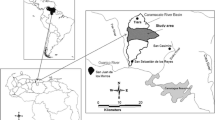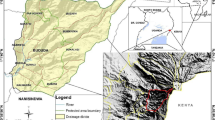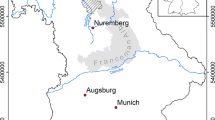Abstract
Recent climate changes are evident, especially in alpine environments, and have implications for natural hazards. Geomorphological studies have been performed at a regional scale in the Aosta Valley to better understand the spatial distribution and frequency of landslides and to investigate their controlling factors. A comparison between areas with permafrost and the rest of the territory has also carried out. Landslides inventories, permafrost distribution and geothematic maps have been produced and integrated into a GIS system. The lowest values of landslides density have been observed within the permafrost areas with respect to the whole region. The frequency of landslides has increased slightly during the last few decades in high mountains areas, possibly due to climate warming.
Access provided by Autonomous University of Puebla. Download conference paper PDF
Similar content being viewed by others
Keywords
1 Introduction
Recent changes in global climate are affecting both polar and alpine environments. The observed effects have significant implications for natural hazards and risks: reduced duration of snow cover, glaciers thinning and retreat, permafrost degradation and increased slope instability in high mountain areas.
Landslides are among the most hazardous geomorphic processes occurring in mountain areas, especially due to their unique geomorphic context: high relief, steep slope gradient and strong climatic variations over small areas. Improving knowledge of past and present slope instability is essential for better understanding their dynamics and developing reliable forecasts of slope performance under future climatic conditions.
We have carried out geomorphological studies in the Aosta Valley, a small alpine watershed in NW Italy, to better understand the spatial distribution and frequency of landslides and to investigate the main factors controlling instability. A comparison between high mountain areas, which are more affected by climate change, and the rest of the territory has been also performed.
2 Geological and Geomorphological Setting
The Aosta Valley is a major alpine valley drained by the Dora Baltea river. Elevations range from 400 m a.s.l., at the valley mouth on the Po Plain, to 4,810 m at Mont Blanc, the highest peak in the European Alps.
The Aosta Valley is located within the axial zone of the Western Alps, which consists of a tectonic stack of continental and oceanic metamorphic units.
Glaciers have played an important role both in eroding the landscape and leaving thick deposits of drift on valley floors. They also have indirectly influenced past and present-day slope dynamics.
Rivers have gradually deepened valleys in the Aosta watershed. Alluvial and alluvial and debris flow fans are widespread and many of them are active, as shown during recent heavy rainstorms (i.e. 13–16 October 2000).
A fundamental role in shaping the geomorphology of the region is played by gravitational phenomena, which range from simple shallow landslide to large slope instabilities. At least 18 % (580 km2) of the watershed area has been affected by landsliding (Ratto et al. 2007).
3 Methods
The methodology used in this research is as follow:
-
production of geo-thematic maps for the study of factors controlling instability;
-
data collection and incorporation in a GIS system;
-
data processing and statistical analysis.
First, slope and aspect maps, derived from a Digital Elevation Model, were produced to analyze topographic factors. Litho-structural data were incorporated by producing a new simplified litho-technical map, derived from regional geological maps (Carta Geotettonica della Valle d’Aosta; De Giusti et al. 2003). (Fig. 83.1). It is a map wherein rock masses originally classified according to their affinity towards the alpine tectonic units have been assembled depending on their litho-technical properties.
In addition to geo-thematic maps, we collected data on slope instabilities derived from landslides inventories (IFFI Project National Database, Regional “Catasto Dissesti”) and added a potential permafrost distribution map layer (Permaclim model, Guglielmin et al. 2003; Alpine Permafrost Map, Boeckli et al. 2012).
The permafrost spatial distribution allowed us to identify two distinct sectors: one with permafrost and the other without permafrost. For each of these two areas, landslide spatial analysis was carried out, which allowed us to consider differences in the frequency, areal extent and types of landslide.
While processing the data, we calculated a “landslide index” (LI), represented by landslide density per parameter class (events/km2), for each factors controlling slope instability taken in account; in particular, we considered topographic (slope and aspect) and litho-structural factors (lithology, spatial distribution of structural discontinuities and rock masses geomechanical conditions).
4 Analysis and Results
4.1 Spatial Landslide Distribution
The data analysis showed that there is less slope instability within permafrost areas than in the rest of the region, both in terms of LI and of the percentage of the total area affected by landslides: 0.5 events/km2 and 11% versus 1.2 events/km2 and 19 % (Table 83.1). Lower values of LI were observed also for almost all classes of the before-mentioned factors of instability (slope, aspect, lithology).
The most common landslide typologies in permafrost areas are rock falls, followed by deep-seated gravitational slope deformations (DSGSD); in contrast, slides and flows are very rare. In terms of the mean areal extent of landslides, the calculated values in permafrost areas are higher for almost all landslide types; e.g. the mean areal extent of rock falls in permafrost areas is considerably greater, more than 40 % over that observed in the rest of the watershed.
4.2 Topographic and Litho-Structural Factors
There is a progressive decrease in LI values with increasing elevation. In contrast, slope gradient analysis showed a progressive increase in the LI values with increasing slope.
Examination of lithological factors reveals that, in permafrost areas, LI values are generally higher for competent lithological units, with the maximum values associated with “carbonatic/evaporitic” rocks. No appreciable variations in LI values were detected with distance from the main structural discontinuities.
4.3 Temporal Landslide Distribution
Our analysis of the temporal distribution of landslides yielded the following conclusions:
-
Landslides frequency has increased in recent years, but this increase may be due to improved reporting of events, especially since 2000, following the establishment of extensive observation and monitoring networks and more widespread use of the new communication technologies.
-
Only 16 % of the recorded events occurred above 2,000 m a.s.l., where rock falls and debris flows dominate, making it difficult to correctly assess landslide frequency in high mountain areas.
-
A slight increase in landslides is evident during the past few decades above 2,000 m a.s.l., albeit with a large interannual variability (Fig. 83.2).
5 Discussions
Permafrost areas in the Aosta Valley have fewer landslides than the rest of the watershed. There are two possible explanations for this difference: (1) There is more awareness of slope processes at lower elevations, as a consequence of the greater human presence there; (2) Permafrost increases the stability of rock and soil, resulting in fewer landslides at high elevations.
Both high LI on steep slopes and in areas of competent lithological units is expressed mainly in frequent rock falls, which occur on steep bedrock valley slopes.
Higher LI on north-facing slopes may indicate more efficient permafrost degradation, resulting in a greater number of landslides involving larger slopes’ sectors.
The lack of data for high mountain areas prevent us from exactly quantifying the role of climate in the observed recent increase in landslides frequency in these areas. Nevertheless, this role has already been established in the Alps, as in the case of rock falls on the Mont Blanc Massif, where a good correlation between slope instability and warming in the past several decades has been established (Ravanel and Deline 2011). According to climatic model scenarios (IPCC 2013) a further increase of rock falls activity on steep high rock slopes can be expected in coming decades.
6 Conclusions
A better understanding of the spatial distribution of landslides and of the main factors controlling slope instabilities, both in permafrost areas and in the rest of the Aosta Valley watershed, has been achieved by this study. Increased landslides frequency and a complex response to climatic forcing have been observed at a regional scale; still, further data on landslides occurrence and improved knowledge on failure mechanisms are needed for high mountain sectors.
References
Boeckli L, Brenning A, Gruber S, Noetzli J (2012) A statistical approach to modelling permafrost distribution in the European Alps or similar mountain ranges. Cryosphere 6:125–140
De Giusti F, Dal Piaz GV, Massironi M, Schiavo A (2003) Carta geotettonica della Valle d’Aosta. Mem Sci Geol 55:129–149
Guglielmin M, Aldighieri B, Testa B (2003) Permaclim: a model for the distribution of mountain permafrost based on climatic observations. Geomorphology 51(4):245–257
IPCC (2013) Climate change 2013: the physical science basis. contribution of working group i to the fifth assessment report of the intergovernmental panel on climate change. Cambridge University Press, Cambridge (in press)
Ratto S, Giardino M, Giordan D, Alberto W, Armand M (2007) Carta dei fenomeni franosi della Valle d’Aosta, scala 1:100.000. Regione Autonoma Valle d’Aosta Assessorato Territorio, Ambiente e Opere Pubbliche. Aosta, Tipografia Valdostana
Ravanel L, Deline P (2011) Climate influence on rockfalls in high-Alpine steep rockwalls: the north side of the Aiguilles de Chamonix (Mont Blanc massif) since the end of the ‘Little Ice Age’. Holocene 21:357–365
Author information
Authors and Affiliations
Corresponding author
Editor information
Editors and Affiliations
Rights and permissions
Copyright information
© 2015 Springer International Publishing Switzerland
About this paper
Cite this paper
Palomba, M., Giardino, M., Ratto, S., Pogliotti, P. (2015). Analysis of Factors Controlling Landslide Susceptibility in the Aosta Valley (NW Italy): Relationship to Climatic and Environmental Changes. In: Lollino, G., Manconi, A., Clague, J., Shan, W., Chiarle, M. (eds) Engineering Geology for Society and Territory - Volume 1. Springer, Cham. https://doi.org/10.1007/978-3-319-09300-0_83
Download citation
DOI: https://doi.org/10.1007/978-3-319-09300-0_83
Published:
Publisher Name: Springer, Cham
Print ISBN: 978-3-319-09299-7
Online ISBN: 978-3-319-09300-0
eBook Packages: Earth and Environmental ScienceEarth and Environmental Science (R0)






